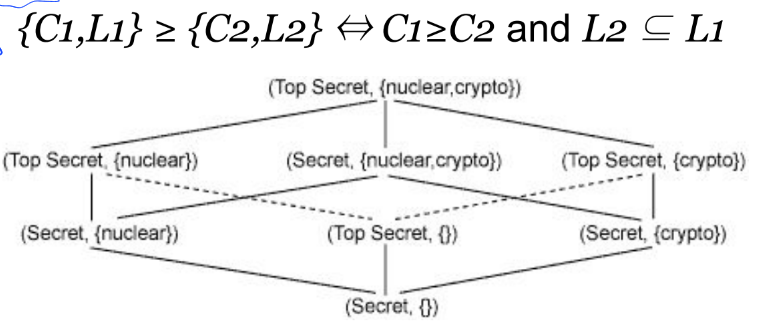Access control
Reference monitor
The reference motior enforces access control policies ("who does what on which resource"). All modern kernels have a reference monitor implementation. The requirements of the reference monitor are:
- Tamper proof
- Connot be bypaased
- Small enouth to be verified and tested with ease
The reference monitor follows the authentication and start the authorization for an object.
Discretionary access control (DAC)
The resource owner discretionarily decides its access privileges. All off-the-shelf OSs are DAC.
In a DAC system the following entities are defined:
- Subjects who can exercise privileges
- Objects on which privileges are exercised
- Actions which can be exercised
For example UNIX is a DAC system where:
- Subjects: user, groups
- Objects: files
- Actions: read, write, execute
We can therefore define the protection state as a triple (S, O, A):
- A is a matrix with S rows and O columns
- A[s,o] are the privileges of subject s over object o
| file1 | file2 | directoryX | |
|---|---|---|---|
| Alice | Read | Read, Write, Own | |
| Bob | Read, Write, Own | Read | Read, Write, Own |
| Charlie | Read, Write | Read |
Enstablishing safety
The basic operations are:
- create (or destroy) subject s
- create (or destroy) object o
- add (or remove) a permission into [s,o] matrix
With these basic operations we can create a transition.
Given an initial protection state and set of transitions, is there any sequence of transitions that leaks a certain right r into the access matrix? If not the system is safe with respect to right r.
This problem is undecidable.
DAC implementations
DAC shortcomings
- Cannot prove safety
- Control access to objects but not to the data inside objects (granularity)
- Susceptible to malicius user problem: an user with access can dump the data
- Susceptible to trojan horse problem: programs that acts as user can access files
- Problem of scalability and management: each user-owner can potentially compromise security of the system with teir own decision (for example, using relaxed authorization)
Mandatory access control (MAC)
Privileges are set by a security administrator and not by owners. The administrator defines a classification of subjects and objects.
The classification is composed of:
- A strictly ordered set of secrecy levels
- A set of labels
An example of MAC is the system used in military, where the following classification is defined: top secret > secret > for official use only > unclassified.
In some classification also labels are used, forming a lattice system.

Role-based access control (RBAC)
RBAC is sort of a "hybrid" between DAC and MAC.
Bell-LaPadula model (BLP)
Defines two MAC rules:
- Simple security property (no read up): A subject s at a given secrecy level cannot read an object o at a higher secrecy level.
- Star property (no write down): A subject s at a given secrecy level cannot write and object o at a lower secrecy level.
Defines one DAC rule: 3. Discretionary security property: use of an access matrix to specify the discretionary access control.
Tranquility property: secrecy levels of objects cannot change dynamically.
The result is a monotonic flow of information toward higher secrecy levels. In the real world there is the need of trusted subjects who can declassify (lower the level) or sanitize (create censored versions of lower levels) documents.
This model does not address integriy.
